2018 School Spending Survey Report
The Big Screen’s 'Dear White People' and a Roundup of Not-to-Miss YA Novels
Dear White People, written and directed by Justin Simien, takes a satirical look at race relations in America. Be prepared for the October 17 premiere with a selection of books for teens that deal with intolerance, civil rights, and racism.
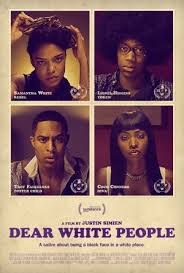 Dear White People (R) depicts the experiences of four African American students as they maneuver through the challenges of campus life and racial politics at a predominantly white (and fictional) college. Firebrand activist Samantha White (Tessa Thompson), host of the purposefully provocative radio show for which the movie is named, has been elected head of Winchester University’s traditionally black residence hall and is determined to save it from being diversified. Meanwhile, Sam’s head-of-house predecessor, Troy Fairbanks (Brandon P. Bell), the establishment-embracing son of the university’s dean, pushes expectations by joining the college’s humor magazine; Afro-wearing sci-fi nerd Lionel Higgins (Tyler James Williams) is recruited by the all-white school newspaper staff to go undercover (though he knows nothing about black culture); and wannabe reality-TV-star Coco Connors (Teyonah Parris) intends to parlay the controversy into a career opportunity. Things come to a boiling point during a Halloween party with a poorly chosen theme torn from the headlines. Written and directed by Justin Simien, this satirical look at race relations in America premieres on October 17. Teens can visit the official website to view a trailer and episodes of “The More You Know (About Black People),” wry PSAs that take on stereotypes with the same sly humor. Great Reads for Teens Dear White People will get teens thinking—regardless of their cultural identity. These compelling novels, all set in the current day, focus on the wide-ranging experiences of African American young adults. The powerfully drawn characters encounter the effects of intolerance and racism, explore the world around them, and make discoveries about themselves and others. Eye-opening and thought-provoking, these books encourage readers to contemplate race in contemporary America and open up much-needed discussion. The View from the Streets
Dear White People (R) depicts the experiences of four African American students as they maneuver through the challenges of campus life and racial politics at a predominantly white (and fictional) college. Firebrand activist Samantha White (Tessa Thompson), host of the purposefully provocative radio show for which the movie is named, has been elected head of Winchester University’s traditionally black residence hall and is determined to save it from being diversified. Meanwhile, Sam’s head-of-house predecessor, Troy Fairbanks (Brandon P. Bell), the establishment-embracing son of the university’s dean, pushes expectations by joining the college’s humor magazine; Afro-wearing sci-fi nerd Lionel Higgins (Tyler James Williams) is recruited by the all-white school newspaper staff to go undercover (though he knows nothing about black culture); and wannabe reality-TV-star Coco Connors (Teyonah Parris) intends to parlay the controversy into a career opportunity. Things come to a boiling point during a Halloween party with a poorly chosen theme torn from the headlines. Written and directed by Justin Simien, this satirical look at race relations in America premieres on October 17. Teens can visit the official website to view a trailer and episodes of “The More You Know (About Black People),” wry PSAs that take on stereotypes with the same sly humor. Great Reads for Teens Dear White People will get teens thinking—regardless of their cultural identity. These compelling novels, all set in the current day, focus on the wide-ranging experiences of African American young adults. The powerfully drawn characters encounter the effects of intolerance and racism, explore the world around them, and make discoveries about themselves and others. Eye-opening and thought-provoking, these books encourage readers to contemplate race in contemporary America and open up much-needed discussion. The View from the Streets 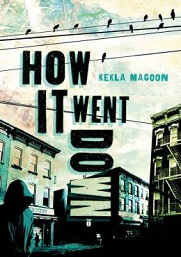 An inner-city neighborhood is thrown into turmoil when Tariq Johnson, a 16-year-old African American, is shot and killed on the street by Jack Franklin, a white man who is apprehended and released after claiming self-defense. Kekla Magoon combines multiple first-person narratives to paint a vivid, heart-rending, and brilliantly multifaceted picture of How It Went Down (Holt, Oct. 2014; Gr 9 Up). Though the facts seem straightforward, the specifics of this racially charged incident are shrouded by uncertainty. Did Tariq have a weapon? Was he wearing gang colors? Even the eyewitness accounts are contradictory. The young man’s family and friends, local gang members, neighborhood residents, and others describe the incident and its aftermath in snapshot–style chapters. Each character has a distinctive voice and life story that influences his or her perspective—including Tariq’s devastated mother; the best friend who relied upon Tariq’s strength and street cred to keep them safe from forced conscription into the Kings; the gang leader equally set on recruiting Tariq into the organization; and a nationally renowned minister who arrives on the scene looking for publicity and political mileage. This timely story becomes more nuanced with each turn of the page, and is as riveting as it is harrowing. Readers get a strong sense of Tariq’s persona, the challenges he faced daily in his community, and the utter tragedy of this senseless act, while also witnessing how personal biases and motivations can affect perceptions. G. Neri addresses another tough taken-from-the-headlines topic in Knockout Games (Lerner/Carolrhoda Lab, 2014; Gr 9 Up). Recently relocated due to her parents’ separation, 15-year-old Erica’s white skin and flaming red hair make her a standout—and a left out—at Truman High, a mostly black school in St. Louis. However, her artistry with a video camera soon puts her on the radar of Kalvin, aka the Knockout King, leader of the TKO club. Consisting mostly of middle schoolers, the TKOs target and assault unsuspecting strangers with a devastating punch to the face—just for the adrenalin rush. Looking for kinship and maybe even fame, Erica becomes their videographer, posting her work on social media, and soon finds herself embroiled in the world of the
An inner-city neighborhood is thrown into turmoil when Tariq Johnson, a 16-year-old African American, is shot and killed on the street by Jack Franklin, a white man who is apprehended and released after claiming self-defense. Kekla Magoon combines multiple first-person narratives to paint a vivid, heart-rending, and brilliantly multifaceted picture of How It Went Down (Holt, Oct. 2014; Gr 9 Up). Though the facts seem straightforward, the specifics of this racially charged incident are shrouded by uncertainty. Did Tariq have a weapon? Was he wearing gang colors? Even the eyewitness accounts are contradictory. The young man’s family and friends, local gang members, neighborhood residents, and others describe the incident and its aftermath in snapshot–style chapters. Each character has a distinctive voice and life story that influences his or her perspective—including Tariq’s devastated mother; the best friend who relied upon Tariq’s strength and street cred to keep them safe from forced conscription into the Kings; the gang leader equally set on recruiting Tariq into the organization; and a nationally renowned minister who arrives on the scene looking for publicity and political mileage. This timely story becomes more nuanced with each turn of the page, and is as riveting as it is harrowing. Readers get a strong sense of Tariq’s persona, the challenges he faced daily in his community, and the utter tragedy of this senseless act, while also witnessing how personal biases and motivations can affect perceptions. G. Neri addresses another tough taken-from-the-headlines topic in Knockout Games (Lerner/Carolrhoda Lab, 2014; Gr 9 Up). Recently relocated due to her parents’ separation, 15-year-old Erica’s white skin and flaming red hair make her a standout—and a left out—at Truman High, a mostly black school in St. Louis. However, her artistry with a video camera soon puts her on the radar of Kalvin, aka the Knockout King, leader of the TKO club. Consisting mostly of middle schoolers, the TKOs target and assault unsuspecting strangers with a devastating punch to the face—just for the adrenalin rush. Looking for kinship and maybe even fame, Erica becomes their videographer, posting her work on social media, and soon finds herself embroiled in the world of the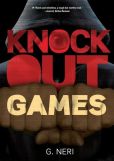 TKOs and attracted to the dangerous yet charismatic Kalvin. As their relationship heats up and the acts of violence escalate—and turn deadly—members of the community speak out and Erica finally begins to see the consequences of their actions with clear eyes and struggles to make hard choices. Neri digs deep into the need for teenagers to find acceptance, not only with his portrayal of Erica, but also with his depictions of TKO members, boys desperate to find a place to belong. Drawn as magnetic and malicious, Kalvin’s multidimensional characterization invites readers to think about how his experiences, perceptions, and emotions influence his behavior. Gritty, gripping, and worthy of discussion. Starring an endearing protagonist nicknamed for his fledgling boxing efforts, Jason Reynolds’s When I Was the Greatest (S. & S., 2014; Gr 7-10) is an engaging and affecting tale of friendship and self-discovery. Ali, 15, lives with his mom and little sister, Jazz, in Brooklyn’s Bed-Stuy neighborhood, where he can most often be found hanging out on the stoop with his best friends, brothers who live in the dilapidated building next door. Noodles, a secret comic-book geek, has an ill-advised penchant for “pulling a caper,” and pushes the
TKOs and attracted to the dangerous yet charismatic Kalvin. As their relationship heats up and the acts of violence escalate—and turn deadly—members of the community speak out and Erica finally begins to see the consequences of their actions with clear eyes and struggles to make hard choices. Neri digs deep into the need for teenagers to find acceptance, not only with his portrayal of Erica, but also with his depictions of TKO members, boys desperate to find a place to belong. Drawn as magnetic and malicious, Kalvin’s multidimensional characterization invites readers to think about how his experiences, perceptions, and emotions influence his behavior. Gritty, gripping, and worthy of discussion. Starring an endearing protagonist nicknamed for his fledgling boxing efforts, Jason Reynolds’s When I Was the Greatest (S. & S., 2014; Gr 7-10) is an engaging and affecting tale of friendship and self-discovery. Ali, 15, lives with his mom and little sister, Jazz, in Brooklyn’s Bed-Stuy neighborhood, where he can most often be found hanging out on the stoop with his best friends, brothers who live in the dilapidated building next door. Noodles, a secret comic-book geek, has an ill-advised penchant for “pulling a caper,” and pushes the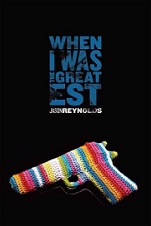 edges of Ali’s patience. They both look after Needles, who has Tourette's syndrome, and has taken to knitting to calm his physical symptoms. When the three wrangle their way into an exclusive adults-only party at a nearby brownstone, trouble erupts, Ali puts his untried pugilistic skills into practice, and all three friends must deal with the evening’s aftereffects. Packed with vivacious dialogue, poetic touches, distinctive details, and appealing humor, the authentic first-person narration creates a strong sense of the action and setting, while also tackling substantial themes including inner-city race and class schisms, taking responsibility for one’s actions, and standing up for what’s right.
edges of Ali’s patience. They both look after Needles, who has Tourette's syndrome, and has taken to knitting to calm his physical symptoms. When the three wrangle their way into an exclusive adults-only party at a nearby brownstone, trouble erupts, Ali puts his untried pugilistic skills into practice, and all three friends must deal with the evening’s aftereffects. Packed with vivacious dialogue, poetic touches, distinctive details, and appealing humor, the authentic first-person narration creates a strong sense of the action and setting, while also tackling substantial themes including inner-city race and class schisms, taking responsibility for one’s actions, and standing up for what’s right. 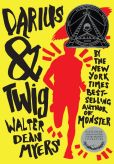 Across the East River in Harlem, best friends and high school juniors Darius & Twig (HarperCollins, 2013; Gr 8 Up) rely on each other to pursue their passions and keep their dreams for the future alive. Darius, a writer, hopes to get a story published to bolster his mediocre grades and win a college scholarship. Twig (Manuel Fernandez), a talented cross-country runner, has been training hard and is beginning to catch the eye of sports recruiters. But first, they will have to survive the challenges that life throws at them daily: unsupportive, overburdened, and absent family members; bullies who seem determined to stop anyone from getting “away from the crappy little universes they had created for themselves;” and a neighborhood where gang warfare, police raids and gunfire are routine (“It is Harlem. It is night. No big deal”). Darius’s first-person narrative eloquently reveals his struggle to find his voice as a writer, the strength he finds in friendship, and his resolve to persevere and be the best that he can be. Walter Dean Myers’s novel is heartfelt and hope-filled. The View from High School
Across the East River in Harlem, best friends and high school juniors Darius & Twig (HarperCollins, 2013; Gr 8 Up) rely on each other to pursue their passions and keep their dreams for the future alive. Darius, a writer, hopes to get a story published to bolster his mediocre grades and win a college scholarship. Twig (Manuel Fernandez), a talented cross-country runner, has been training hard and is beginning to catch the eye of sports recruiters. But first, they will have to survive the challenges that life throws at them daily: unsupportive, overburdened, and absent family members; bullies who seem determined to stop anyone from getting “away from the crappy little universes they had created for themselves;” and a neighborhood where gang warfare, police raids and gunfire are routine (“It is Harlem. It is night. No big deal”). Darius’s first-person narrative eloquently reveals his struggle to find his voice as a writer, the strength he finds in friendship, and his resolve to persevere and be the best that he can be. Walter Dean Myers’s novel is heartfelt and hope-filled. The View from High School 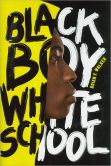 In Brian F. Walker’s Black Boy White School (HarperTeen, 2012; Gr 9 Up), 14-year-old Anthony Jones, also an aspiring writer, leaves his rough East Cleveland neighborhood and heads to an elite prep school in Maine (Ant decides to accept a scholarship offer after his best friend Mookie is killed in a random shooting). At Belton Academy, he feels “adrift in a Caucasian sea” and struggles to adapt to the mostly upper-class crowd and fight against stereotypes (many of his well-intentioned classmates assume that he’s from Brooklyn and plays basketball). He encounters blatant prejudice in a local community strained by the arrival of numerous Somali refugees. Pressured to conform to the expectations of students and faculty and determined to succeed, he feels as though he is losing his identity, and finds himself equally out of place during visits home. As challenges multiply and events unfold, Ant must discover a way to function in both worlds, while remaining true to himself. Based on the author’s similar personal experiences, this thought-provoking novel is written with a potent and engrossing narrative voice.
In Brian F. Walker’s Black Boy White School (HarperTeen, 2012; Gr 9 Up), 14-year-old Anthony Jones, also an aspiring writer, leaves his rough East Cleveland neighborhood and heads to an elite prep school in Maine (Ant decides to accept a scholarship offer after his best friend Mookie is killed in a random shooting). At Belton Academy, he feels “adrift in a Caucasian sea” and struggles to adapt to the mostly upper-class crowd and fight against stereotypes (many of his well-intentioned classmates assume that he’s from Brooklyn and plays basketball). He encounters blatant prejudice in a local community strained by the arrival of numerous Somali refugees. Pressured to conform to the expectations of students and faculty and determined to succeed, he feels as though he is losing his identity, and finds himself equally out of place during visits home. As challenges multiply and events unfold, Ant must discover a way to function in both worlds, while remaining true to himself. Based on the author’s similar personal experiences, this thought-provoking novel is written with a potent and engrossing narrative voice. 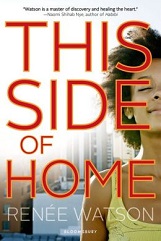 Scheduled for publication in February of 2015, Renée Watson’s This Side of Home (Bloomsbury, Gr 7 Up) is told from the viewpoint of Maya Younger, who, like her identical twin sister Nikki, was named by their community activist parents for Mom’s favorite poets. Both girls are seniors at Portland’s Richmond High, a school that has often garnered media attention for violence, but their down-and-out neighborhood is beginning to change, with white families moving in and upscale businesses blossoming. Nikki embraces the transformation while Maya feels as though the roots of their community are crumbling. Different faces are also showing up at school, where the new principal is determined to focus on the newfound racial diversity at the expense of its traditional core. As president of the student council, Maya fights for what she holds dear—such as retaining their annual Black History Month celebration—while also trying to win media attention for the positive things that are happening there. However, her beliefs and self-perceptions are shaken when she falls for Tony, the white boy who has moved in across the street. In this accessible and enchanting novel, Watson raises difficult questions about race relations, the tough situations faced by African American teens, and how we see ourselves and the people we love.
Scheduled for publication in February of 2015, Renée Watson’s This Side of Home (Bloomsbury, Gr 7 Up) is told from the viewpoint of Maya Younger, who, like her identical twin sister Nikki, was named by their community activist parents for Mom’s favorite poets. Both girls are seniors at Portland’s Richmond High, a school that has often garnered media attention for violence, but their down-and-out neighborhood is beginning to change, with white families moving in and upscale businesses blossoming. Nikki embraces the transformation while Maya feels as though the roots of their community are crumbling. Different faces are also showing up at school, where the new principal is determined to focus on the newfound racial diversity at the expense of its traditional core. As president of the student council, Maya fights for what she holds dear—such as retaining their annual Black History Month celebration—while also trying to win media attention for the positive things that are happening there. However, her beliefs and self-perceptions are shaken when she falls for Tony, the white boy who has moved in across the street. In this accessible and enchanting novel, Watson raises difficult questions about race relations, the tough situations faced by African American teens, and how we see ourselves and the people we love. 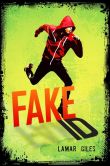 Arriving at his new high school in Stepton, Georgia, with his latest Fake ID (Amistad, 2014; Gr 9 Up) in hand, Nick Pearson plans to keep a low profile. Several years ago his father agreed to testify against a dangerous crime boss, and the family has been part of the Witness Protection Program ever since, relocating and changing names four times due to Dad’s inability to stop dabbling in criminal ventures. Nick is befriended by Eli Cruz, an aspiring journalist who singlehandedly runs the school newspaper. Eli tries to recruit Nick by alluding to “Whispertown,” a scandal that will blow the lid off their small town. When Eli is found dead in the journalism room a few days later, the police rule it a suicide, but Nick and Eli’s sister Reya suspect that Eli may have uncovered deadly information and are determined to get to the truth. Racial tensions are subtlety woven into the narrative, which is propelled forward by heart-pounding suspense, intertwining mysteries, and danger-fraught action (as well as Nick’s burgeoning romance with Reya). Lamar Giles’s thrill-filled narrative is at times humorous, often self-reflective, and always enthralling. The View from the Heart
Arriving at his new high school in Stepton, Georgia, with his latest Fake ID (Amistad, 2014; Gr 9 Up) in hand, Nick Pearson plans to keep a low profile. Several years ago his father agreed to testify against a dangerous crime boss, and the family has been part of the Witness Protection Program ever since, relocating and changing names four times due to Dad’s inability to stop dabbling in criminal ventures. Nick is befriended by Eli Cruz, an aspiring journalist who singlehandedly runs the school newspaper. Eli tries to recruit Nick by alluding to “Whispertown,” a scandal that will blow the lid off their small town. When Eli is found dead in the journalism room a few days later, the police rule it a suicide, but Nick and Eli’s sister Reya suspect that Eli may have uncovered deadly information and are determined to get to the truth. Racial tensions are subtlety woven into the narrative, which is propelled forward by heart-pounding suspense, intertwining mysteries, and danger-fraught action (as well as Nick’s burgeoning romance with Reya). Lamar Giles’s thrill-filled narrative is at times humorous, often self-reflective, and always enthralling. The View from the Heart 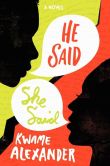 Kwame Alexander’s He Said, She Said (HarperCollins, 2013; Gr 10 Up) combines a star-crossed romance with a burgeoning sense of social conscious. Transplanted from Brooklyn to South Carolina’s West Charleston High, senior Omar “T-Diddy” Smalls’s slick skills as quarterback of a state champion team have earned him media fame and a full ride to the University of Miami, and the only thing he loves more than football is being a “playa” with the ladies (with a capital S). Claudia Clark is a straight-laced, straight-A Harvard-bound student who writes for the school paper. When the school board makes drastic cuts to the arts budget, these two polar opposites find themselves on the same side of a protest to restore the funding. As the movement grows—via T-Diddy’s surprisingly effective leadership and Dr. King-inspired acts of civil disobedience—so does their attraction to each other, and they just might end up falling in love. Told in alternating chapters by each of the protagonists, the narrative zings with lively dialect and sometimes explicit street slang, Facebook posts, emails, and newspaper articles. This sweet and satisfying romance packs a positive message along with plenty of heart.
Kwame Alexander’s He Said, She Said (HarperCollins, 2013; Gr 10 Up) combines a star-crossed romance with a burgeoning sense of social conscious. Transplanted from Brooklyn to South Carolina’s West Charleston High, senior Omar “T-Diddy” Smalls’s slick skills as quarterback of a state champion team have earned him media fame and a full ride to the University of Miami, and the only thing he loves more than football is being a “playa” with the ladies (with a capital S). Claudia Clark is a straight-laced, straight-A Harvard-bound student who writes for the school paper. When the school board makes drastic cuts to the arts budget, these two polar opposites find themselves on the same side of a protest to restore the funding. As the movement grows—via T-Diddy’s surprisingly effective leadership and Dr. King-inspired acts of civil disobedience—so does their attraction to each other, and they just might end up falling in love. Told in alternating chapters by each of the protagonists, the narrative zings with lively dialect and sometimes explicit street slang, Facebook posts, emails, and newspaper articles. This sweet and satisfying romance packs a positive message along with plenty of heart. 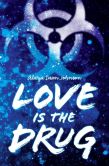 Part bio-thriller, part sizzling romance, and part journey of self-discovery, Alaya Dawn Johnson’s Love Is the Drug (Scholastic, 2014, Gr 10 Up) is absolutely captivating. The daughter of two well-respected African-American scientists, Emily Bird, 17, attends an exclusive Washington D.C. prep school, has the perfect socially acceptable and professionally ambitious boyfriend, and is on the fast track to an Ivy League school. However, she secretly longs for a different kind of life. After attending a party at a senator’s home, she wakes up eight days later in the hospital and soon ascertains that she was given an unidentified memory-clouding drug. Her efforts to piece together what happened that night puts her squarely in the sights of an intimidating national security contractor and into the arms of Coffee, classmate and son of a Brazilian diplomat. Though Coffee has a drug-dealing dark side, he sees in her the powerful woman that she is capable of becoming. Meanwhile, a deadly pandemic flu deployed by foreign bio-terrorists has D.C. strictly quarantined and under military law. Suspense builds, as she begins to uncover astounding secrets, and clues lead her to dangerous discoveries about the flu’s origins. Falling more and more deeply in love with Coffee, Bird gradually casts off the confining expectations that have been placed upon her and truly begins to soar. Instances of discrimination due to race and social class are woven into the narrative, which also touches upon racial identity. Sophisticated, complex, and lyrically written, this novel will satisfy teens looking for a substantial read. Looking for a way to expand the discussion? See the SLJ article #Two apps on the Civil Right Movement and a pirate story headline our best-of-the-month column# Publication Information Alexander, Kwame. He Said, She Said. HarperCollins/Amistad. 2013. Tr $17.99. ISBN 978-0-06-211896-7; ebook $9.99. ISBN 978-0-06-211899-8; pap. $9.99. ISBN 978-0-06-211898-1. Giles, Lamar. Fake ID. HarperCollins/Amistad. 2014. Tr $17.99. ISBN 978-0-06-212184-4; ebook $9.99. ISBN 978-0-06-212186-8. Johnson, Alaya Dawn. Love Is the Drug. Scholastic/Arthur A. Levine Bks. 2014. Tr $17.99. ISBN 978-0-545-41781-5; ebook $17.99. ISBN 978-0-545-66289-5. Magoon, Kekla. How It Went Down. Holt. Oct. 2014. Tr $17.99. ISBN 9780805098693; ebook $9.99. ISBN 9781627791595. Myers, Walter Dean. Darius & Twig. HarperCollins/Amistad. 2013. Tr $17.99. ISBN 978-0-06-172823-5; ebook $9.99. ISBN 978-0-06-220925-2; pap. $9.99. ISBN 978-0-06-172825-9. Neri, G. Knockout Games. Lerner/Carolrhoda Lab. 2014. Tr $17.95. ISBN 978-1-4677-3269-7. Reynolds, Jason. When I Was the Greatest. S. & S./Atheneum. 2014. Tr $17.99. ISBN 978-1-4424-5947-2; ebook $10.99. ISBN 978-1-4424-5949-6. Walker. Brian F. Black Boy White School. HarperTeen. 2012. Tr $17.99. ISBN 978-0-06-191483-6; ebook $11.99. ISBN 978-0-06-209917-4. Watson, Renée. This Side of Home. Bloomsbury. Feb. 2015. Tr $17.99. ISBN 978-1-5999-0668-3.
Part bio-thriller, part sizzling romance, and part journey of self-discovery, Alaya Dawn Johnson’s Love Is the Drug (Scholastic, 2014, Gr 10 Up) is absolutely captivating. The daughter of two well-respected African-American scientists, Emily Bird, 17, attends an exclusive Washington D.C. prep school, has the perfect socially acceptable and professionally ambitious boyfriend, and is on the fast track to an Ivy League school. However, she secretly longs for a different kind of life. After attending a party at a senator’s home, she wakes up eight days later in the hospital and soon ascertains that she was given an unidentified memory-clouding drug. Her efforts to piece together what happened that night puts her squarely in the sights of an intimidating national security contractor and into the arms of Coffee, classmate and son of a Brazilian diplomat. Though Coffee has a drug-dealing dark side, he sees in her the powerful woman that she is capable of becoming. Meanwhile, a deadly pandemic flu deployed by foreign bio-terrorists has D.C. strictly quarantined and under military law. Suspense builds, as she begins to uncover astounding secrets, and clues lead her to dangerous discoveries about the flu’s origins. Falling more and more deeply in love with Coffee, Bird gradually casts off the confining expectations that have been placed upon her and truly begins to soar. Instances of discrimination due to race and social class are woven into the narrative, which also touches upon racial identity. Sophisticated, complex, and lyrically written, this novel will satisfy teens looking for a substantial read. Looking for a way to expand the discussion? See the SLJ article #Two apps on the Civil Right Movement and a pirate story headline our best-of-the-month column# Publication Information Alexander, Kwame. He Said, She Said. HarperCollins/Amistad. 2013. Tr $17.99. ISBN 978-0-06-211896-7; ebook $9.99. ISBN 978-0-06-211899-8; pap. $9.99. ISBN 978-0-06-211898-1. Giles, Lamar. Fake ID. HarperCollins/Amistad. 2014. Tr $17.99. ISBN 978-0-06-212184-4; ebook $9.99. ISBN 978-0-06-212186-8. Johnson, Alaya Dawn. Love Is the Drug. Scholastic/Arthur A. Levine Bks. 2014. Tr $17.99. ISBN 978-0-545-41781-5; ebook $17.99. ISBN 978-0-545-66289-5. Magoon, Kekla. How It Went Down. Holt. Oct. 2014. Tr $17.99. ISBN 9780805098693; ebook $9.99. ISBN 9781627791595. Myers, Walter Dean. Darius & Twig. HarperCollins/Amistad. 2013. Tr $17.99. ISBN 978-0-06-172823-5; ebook $9.99. ISBN 978-0-06-220925-2; pap. $9.99. ISBN 978-0-06-172825-9. Neri, G. Knockout Games. Lerner/Carolrhoda Lab. 2014. Tr $17.95. ISBN 978-1-4677-3269-7. Reynolds, Jason. When I Was the Greatest. S. & S./Atheneum. 2014. Tr $17.99. ISBN 978-1-4424-5947-2; ebook $10.99. ISBN 978-1-4424-5949-6. Walker. Brian F. Black Boy White School. HarperTeen. 2012. Tr $17.99. ISBN 978-0-06-191483-6; ebook $11.99. ISBN 978-0-06-209917-4. Watson, Renée. This Side of Home. Bloomsbury. Feb. 2015. Tr $17.99. ISBN 978-1-5999-0668-3. RELATED
RECOMMENDED
CAREERS
The job outlook in 2030: Librarians will be in demand
CAREERS
The job outlook in 2030: Librarians will be in demand
ALREADY A SUBSCRIBER? LOG IN
We are currently offering this content for free. Sign up now to activate your personal profile, where you can save articles for future viewing






Add Comment :-
Be the first reader to comment.
Comment Policy:
Comment should not be empty !!!